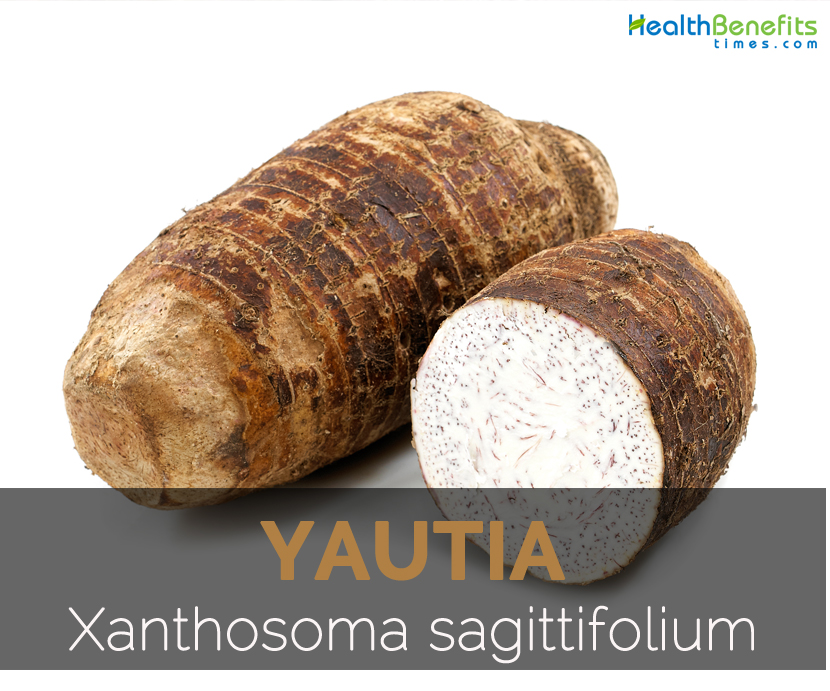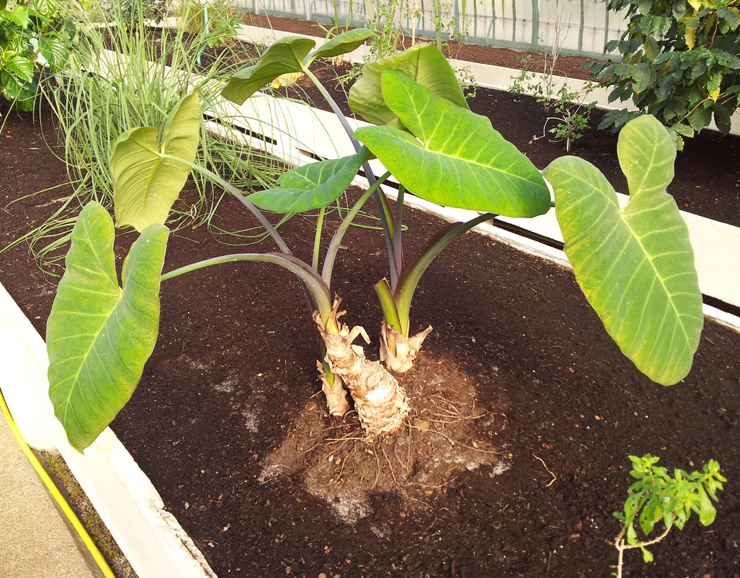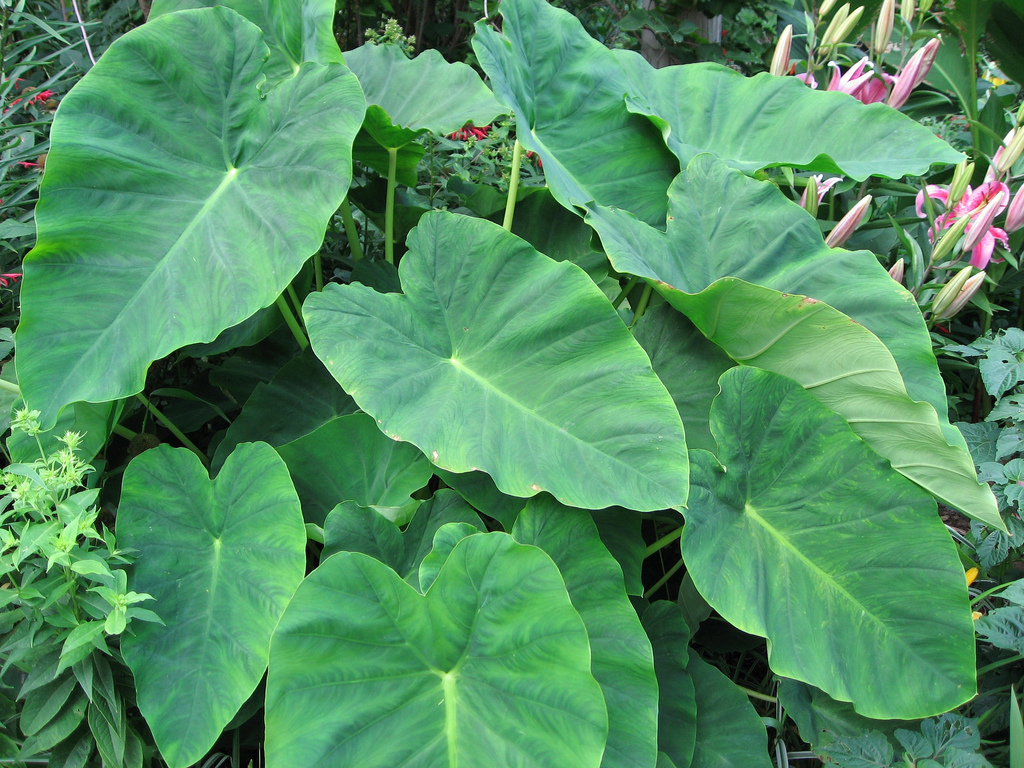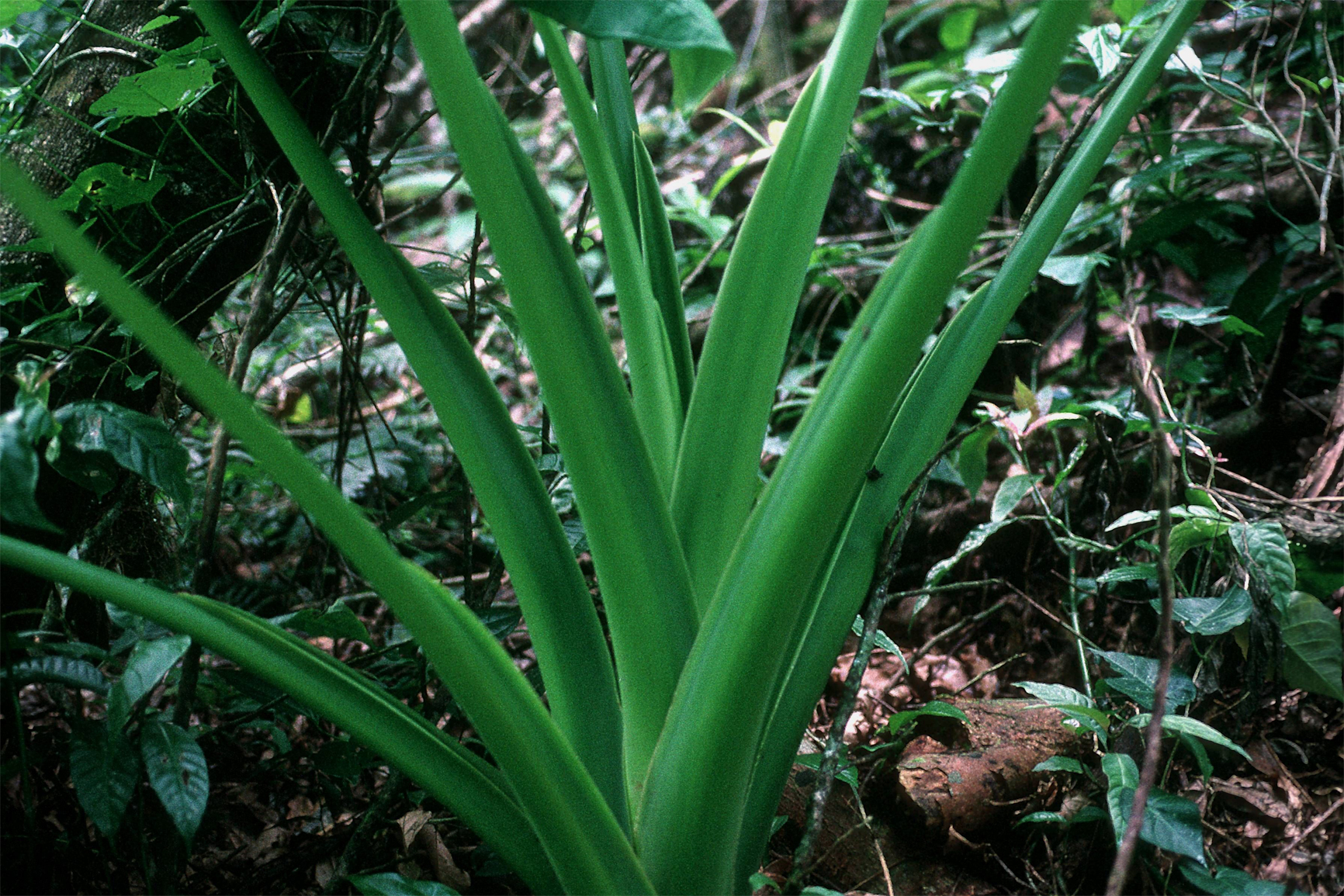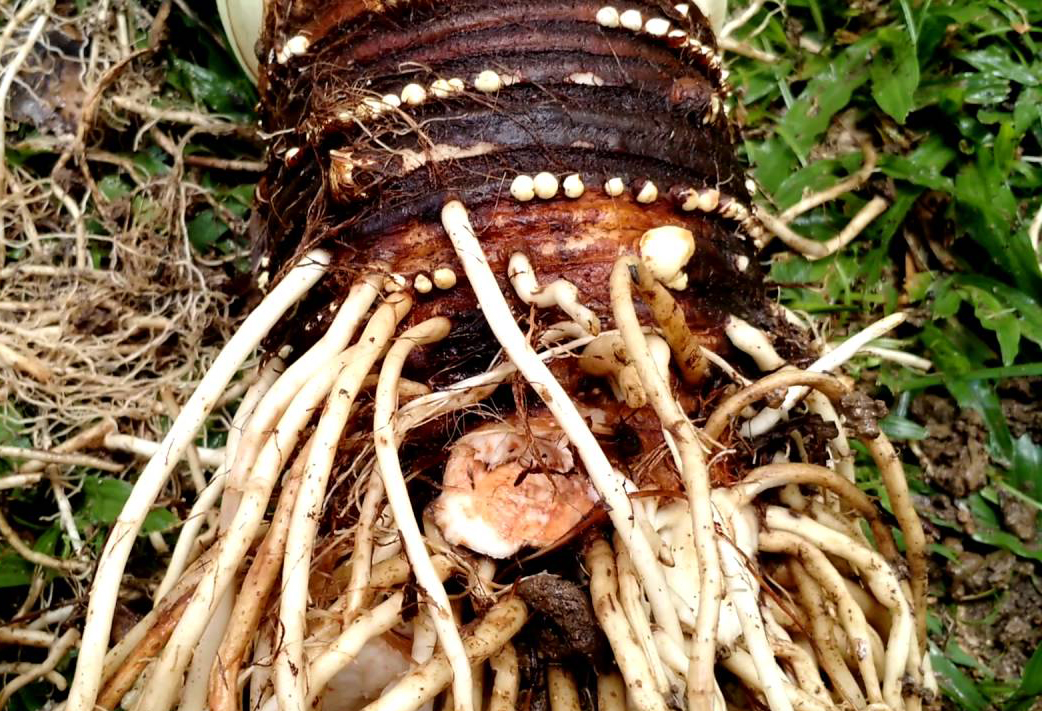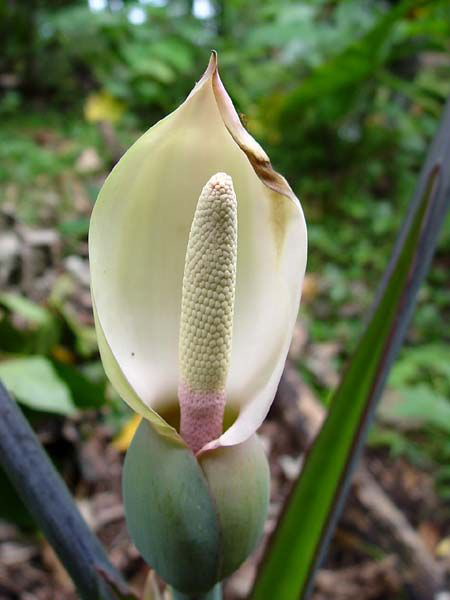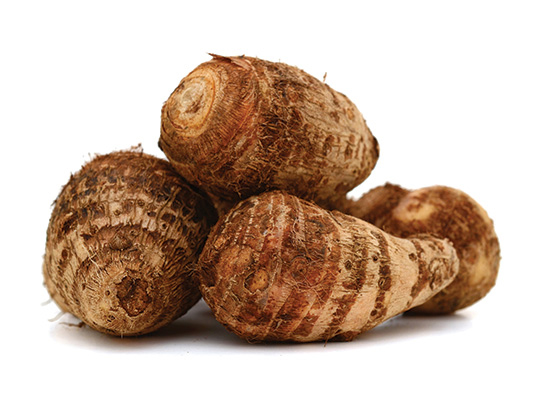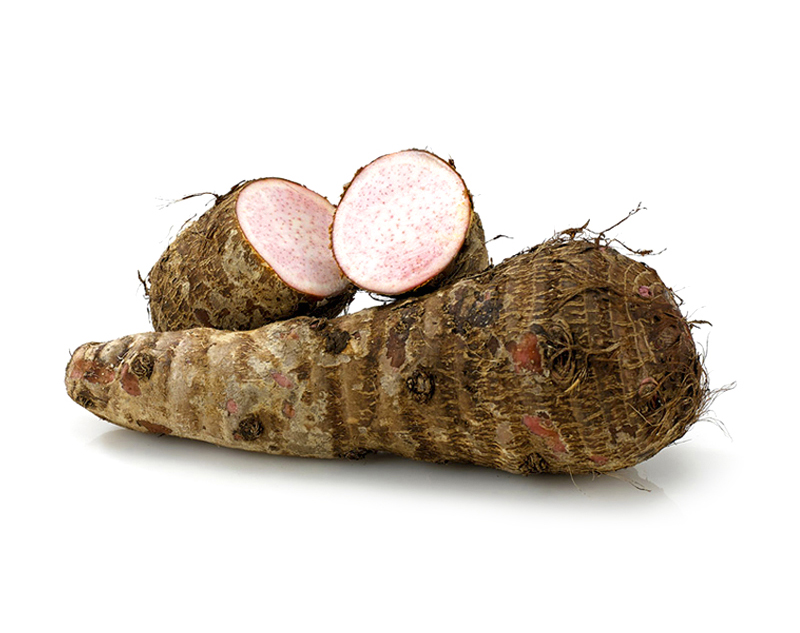| Yautia Quick Facts |
| Name: |
Yautia |
| Scientific Name: |
Xanthosoma sagittifolium |
| Origin |
Northern South America which extent to Mesoamerica and the Caribbean and then introduced everywhere to Asia, Africa and Pacific. |
| Colors |
Dark brown-orange skin with wiry hair (Tuber) |
| Flesh colors |
White or light yellow |
| Calories |
132 Kcal./cup |
| Major nutrients |
Copper (38.56%)
Vitamin B6 (24.62%)
Carbohydrate (24.54%)
Potassium (17.17%)
Iron (16.50%)
|
| Health benefits |
Brain health, Thyroid problems, Promote mood, Cure anemia, Blood vessels |
| More facts about Yautia |
Yautia commonly refers to the plant Xanthosoma sagittifolium, the generally cultivated species of several plants in the family Araceae which is usually grown for their corms, petioles and leaves. Yautia is native to Northern South America which is cultivated widely in various parts of the world. It is known by many local names including American Taro, Barbados Nut Eddoe, Arrowleaf Elephant’s Ear, Cocoyam, Green Arrow Elephant Ears, Elephant Ears, New Cocoyam, Malanga, Tannia, Yannia Leaf Spinach, Uyautia, Yautia, Yellow Yautia, Yautia Tannia and Yellow Ocumo.
It is a lactiferous, unarmed herb which prefers tropical and sub-tropical climates with well-drained and fertile soils. The roots are tuberous, fibrous and fairly extensive. The fruit of this plant is a small and yellow berry. It is widely used for the consumption purpose and added to various recipes.
History
Inherent to Northern South America, it extent to Mesoamerica and the Caribbean and then introduced everywhere to Asia, Africa and Pacific.
Firstly, it was cultivated in Tropical America which spread in mid 1800s to Africa. It is also cultivated in Philippines. They are quite famous in Cuba and Puerto Rico.
It is considered as one of the oldest root crops in the world which was brought first to the Marshall Islands at the time of Japanese administration. Within the last century, different varieties are introduced to the Marshall Islands.
Plant
Yautia is an herbaceous, stout and perennial herb which grows up to 1.5-2 m in height. The plant have arrowhead to heart shaped leaves which are glabrous, 90 cm long and 60 cm wide. The leaves are thick and dark green. The stems are thick, underground and tuberous. Tubers have dark brown-orange skin which possesses wiry hair. The flesh inside the corm is white. The spathe is 15-25 cm long whereas spadix is 15 cm in length.
Nutritional value
There are 132 calories in 1 cup of 135 grams. It provides ample amounts of nutrients, minerals, vitamins and lipids. The same cup offers 0.347 mg of copper, 0.32 mg of Vitamin B6, 31.9 grams of carbohydrate, 807 mg of potassium, 1.32 mg of iron, 0.131 mg of vitamin B1 and 0.251 mg of manganese.
Health Benefits of Yautia
Yautia is rich in copper, vitamin B6, carbohydrates, potassium and iron. It is considered as the lowest allergenic food which makes it a good diet for the people who experience various food allergic situations. It enhances the energy and maintains the level of blood sugar. It helps to maintain gut and manages blood pressure.
- Brain health
The pathways such as galactose and dopamine are affected by the copper. These neurotransmitters help to maintain energy, happy mood, outlook and focus. The deficiency of copper leads to fatigue, low metabolic activity, poor mood and problem in concentration. Copper helps to utilize antioxidants such as superoxide dismutase, Vitamin C, tyrosinase and ascorbate oxidase. These helps to prevent the damage caused by free radicals in the brain and also slows down the aging process and neurodegenerative disease.
- Thyroid problems
Copper is essential for the function of thyroid because it balances the activities of thyroid by working with other minerals such as calcium, potassium and zinc. It also prevents the health conditions such as hyperthyroidism or hypothyroidism. If any of the minerals are excessive in the body then one can suffer from thyroid which leads to weight loss or gain, fatigue, change in appetite or body temperature and other symptoms.
- Promote mood
The research shows that Vitamin B6 has a serious impact on the production of GABA neurotransmitters and serotonin in the brain. These hormones help to maintain the mood and prevents from fatigue, pain, anxiety and depression. So vitamin B6 helps to prevent the mood disorders.
Vitamin B6 helps to produce the hormones which cure the brain diseases and mood disorders which arise from the deficiency in the neurotransmitter functions. The supplement of Vitamin B6 uplifts the mood, less pain, energy and concentration problem.
- Cure anemia
Vitamin B6 is essential for the production of hemoglobin in blood because the red blood cells assist in transporting oxygen to the cells and also mobilizes iron. Anemia is the situation caused due to the low presence of red blood cells and results in aches, pain and fatigue. An adequate intake of Vitamin B6 reduces the symptoms of anemia and also prevents it from developing.
- Blood vessels
Vitamin B6 assist in the regulation of homocysteine levels in the blood. The high amount of homocysteine levels results in inflammation, heart disease, blood vessel disease that results in heart attack.
The homocysteine develops in the absence of vitamin B6 that could damage the blood vessel linings which may lead to the stroke or heart attack. The homocysteine levels are reduced when vitamin B6 is intake with folate. It also helps to maintain the cholesterol and blood pressure level which are the main causes that leads to heart disease.
- Heart ailments
Potassium manages the heart activity which balances the circulation, rhythm of heart beats and blood pressure. The studies have shown that the diet which is rich in sodium and low in potassium contributes to the hypertension, high blood pressure and cardiovascular diseases. Potassium combines with the minerals such as magnesium and calcium which helps to prohibit the buildup of fluid in the cells. The deficiency of potassium leads to chest pains, irregular heartbeats as well as cardiac arrest.
- Kidney ailments
The high intake of potassium reduces the chances of forming kidney stones. Kidney stones are caused due to the low presence of potassium and opposite relationship between calcium and potassium. The excess calcium is excreted in the presence of low level of potassium through urine which pass through kidneys. Kidney stones are the deposits of calcium which could be reduced in urine to combat the kidney problems.
- Pregnancy
During pregnancy, the deficiency of iron increases the chances of premature birth or underweight newborn that experiences various health problems such as poor cognitive development and delay growth. The study shows that the high intake of iron reduces the chances of underweight newborn by 8.4 percent in comparison to those who does not.
- Enhance immunity
Vitamin B1 tones the wall muscles of digestive tract. The digestive tract helps to absorb nutrients from the foods that enhance the immunity and prevent from sickness. Vitamin B1 also assists in hydrochloric acid secretion that is vital for the digestion of food as well as nutrient absorption.
- Detoxification
Kidneys eliminate the organic molecules in the blood. It is essential for the functioning of kidneys and eliminates waste and toxins through the urine. The digestive organs and kidneys depend upon the electrolytes such as potassium, magnesium and phosphorus to balance sodium, fat and water in the body. Phosphate is found in the body as phosphate ions by blending with other electrolytes.
Traditional uses
- The large leaves are used in Peninsular Malaysia to provide relief from fever.
- The inflorescence sap is used in Palawan to cure wounds and also as an antidote for stings and insect bites.
- It was used in northwest Amazonia to cure snake bites.
Precautions
- The sap of this plant could provide irritation to the skin.
- Calcium oxalate crystals are found in Yautia which could irritate throat and mouth if it is ingested.
How to Eat
- The shredded leaves are added to the ingredients and are cooked either by boiling, steaming, frying or baking.
- The corm is added in soups, stews or boiled like a potato.
- It is also used in dishes such as guanime, sancocho, alcapurrias and mondongo.
- In Netherlands and Suriname, the shredded root is cooked in oven with fruit juices, chicken, spices and salted meat.
- Yautia flour is a substitute for wheat flour for making quick breads, cookies and other items.
- Yautia is used as a thickener for stews and soups.
- The root could be peeled, sliced and fried like a chips or pureed for a cold or hot soup.
- The root of Yautia could be dried and ground to flour.
- They are boiled, baked, steamed, fried, grilled, mashed, pureed, creamed, in soups, chowders, stews, salads and barbecued.
- The corms are peeled, dried and ground to meal or flour to make puddings.
- Yautia is used to brew beer due to its high content of carbohydrate.
Comments
comments


